
ejw50
-
Posts
334 -
Joined
-
Last visited
Content Type
Profiles
Forums
Store
Help Articles
Posts posted by ejw50
-
-
I guess my other issue is that I'm not a pro. I make chocolates only 12 days of the year (~3200 pieces a year).
So with that level of practice, fluctuations in my technique (both in molding and in ganache prep) will dominate over incremental improvement of going from Callebaut to Valrhona or Cluizel or Felchlin or whatever.
And it's not as if Callebaut is bad - many pros use it too.
I think I can think of maybe 1 person in my audience who would be able to tell I used Valrhona instead of Callebaut - for the shell anyway, in some cases the chocolate used in the ganache will make a big difference as Truffle guy notes. The shells are supposed to be thin anyway, right?
I think that going to 815 from 811 would make a bigger difference in shell and wouldn't cost you any more.
-
here's a list of what some pros use (taken from the article exposing Noka chocolate http://www.dallasfood.org/modules.php?name...article&sid=83)
Info is not mine, see article for more explanations
Michael Recchiuti's -E. Guittard, El Rey, and Scharffen Berger.
La Maison du Chocolat - Valrhona exclusively.
Vosges - Valrhona, Felchlin, and Belcolade.
Jacques Torres's - Belcolade
Gale Gand's truffles at Tru Callebaut for the ganache.
Norman Love's - Felchlin
Knipschildt's - Valrhona, Belcolade, and Cluizel
MarieBelle's Valrhona.
Fran's Chocolates - Valrhona, Felchlin, and Callebaut
Richard Donnelly - Valrhona, Callebaut, and Cacao Barry
Brian McElrath - Vintage Plantations, E. Guittard, Belcolade, et al.
Chuao - El Rey
Garrison Confections- Guittard
Lake Champlain Chocolates - Callebaut.
-
I guess my philosophy is much more simple.
I find something cheap that tastes pretty good. For me, this is Callebaut. I tend more towards "American style" ganache where the flavor is stronger (vs. French Style where the flavor is faint). So going from '95/100' to '98/100' isn't necessarily worth it if the '98/100' chocolate is more expensive.
I use other chocolate in just two cases: guanaja for Palet d'ors, and ivoire for vanilla bean ganache.
The other thing is that 95% of my audience can't tell the difference between Callebaut and Cluzel or Valrhona or Felchlin or any of the more expensive brands. So there isn't that much point to using something better (and more $$) to impress those 5%. Most people are far more impressed that I can airbrush or spatter or paint cocoa butter than with an incrementally better chocolate.
I know that's sad for chocolate snobs, but that's what I see.
-
Parchment sheets on the counter tops under the bowl of tempered chocolate.
Roll of paper towels easily accessible for wiping as required.
I scrape my tools back into the pyrex measuring cup I'm working from and hit them with the heat gun and wipe with a paper towel (or wash in the sink) frequently so they don't have chocolate on the edges when I'm trying to scrape molds.
A big bowl is a great idea by the way. The 6 kg melter that I have is nice and big and rectangular - great for working clean. But (thanks to JP Wybauw) cover the bottom with saran before I put the removable insert in place and it keeps the whole thing clean.
Hey Kerry thanks for the parchment tip which you mentioned a while back. It made my cleanup a lot faster this last weekend.
Lastly, thanks to this forum for explaining how the spatter technique works and some of the difficulties. I ended up cleaning my sink with alcohol, then putting my molds in the sink to spatter. I lined the near wall with flexible plastic cutting boards, and that pretty much did the trick. I dipped the whisk into cocoa butter and did a 'clapping' motion and it mostly all wo rked! The only thing to clean was the sink, which was easy! The boards went straight into the washing machine. Nothing on the walls at all, and only a little on the countertops!
-
 1
1
-
-
yeah, I wanted to buy these books for presents since both of them are great. Plus, PH's other books are either in French or 100's of dollars. Disappointing to see that they are out of print.
-
I did not read the whole thread, but is this book still available? I am not seeing it on Amazon for new.
-
if I remember correctly, he does use cocoa butter in his peanut butter ones. So it's not as if he is afraid of listing it as an ingredient.
-
In Pierre Herme's book, he makes enrobed chocolates eith luster dust and acetate sheet covering. Even for PH, there are pits everywhere, I think that kind of thing is a definite issue when put the dust between the chocolate and the mold/sheet
I've taken to what Kerry does and mixed the dust with cocoa butter.
Another technique you can do is to dust them or tap on dust afterwards instead. I saw Fritz Knipschildt do this in his throwdown vs. Bobby Flay.
-
When dipping, I expect that the chocolate will become thicker and thicker (due to an over abundance of beta crystals) as I work. I always keep a heat gun by the melter to hit the chocolate from time to time to keep it fluid. You just have to be careful not to overheat it and, therefore, move it out of temper. Stir well!
Hmmm. I need to buy a heat gun.
So before I had the melter, when I had to keep re-heating in the microwave to keep temperature, did that do the same thing as using a heat gun as far as keeping the chocolate liquid?
If whatever you're dipping hasn't set-up, then contamination of the chocolate can be an issue. How did you dip it if the ganache hadn't set up?The ganache wasn't completely liquidy, but it wouldn't hold its shape if it was touched or handled in any way. It was probably the texture of soft butter. I pre-bottomed with a layer of chocolate and that helped the pieces hold their shape and gave me something to hold onto while I dropped them into the chocolate.
emmalish, you can also just use the microwave as before. Reheat a small portion and mix it in, and then you don't need a heat gun.
In his book, JPW recommends not to use cocoa butter once it's thickened. slight heating is the way to go. Actually, JPW mentions something else- an alternative to the heat gun is to keep on raising the temperature slightly over time, up to 93.5 for dark chocolate. The bottom will be undertempered, the top will be overtempered, and when you mix them it will be perfect.
-
I had read about Kee's creme brulee truffle, speculated about how it was done, and finally decided to try it myself.
I didn't want to settle for a "creme" truffle but wanted to try for the sugar crust as well. There are several ways to get a thin chunk of carmalized sugar. For this attempt I carmalized in a pot, poured it between to silpats and spread it thin with a scraper. When cooled I broke the sheet up into smaller pieces. In the future I might try using a stencil to lay out piles of sugar to carmalize with a torch so I can get more consistent sizing with less waste.
Since the sugar would be sealed in the creme for several hours before it was eaten I decided to coat them in cocoa butter for protection. I melted a bit of butter in a small cup and dipped the pieces in and laid them out on a silpat to set.
The cocoa butter protected the sugar, but I didn't particularly like the way it interfered with the flavor. The next time I might try spraying it with an airbrush or dip in chocolate instead.
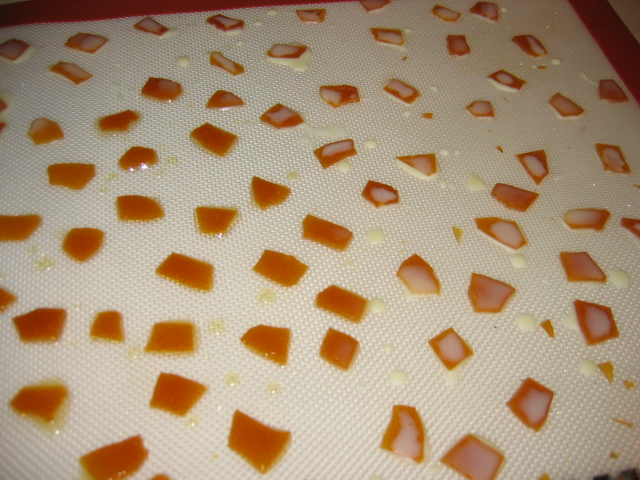
I made the creme anglese and cooled it in the fridge until it wouldn't melt the dark chocolate shells. It proved to still be pipeable, though it was a touch on the thick side.
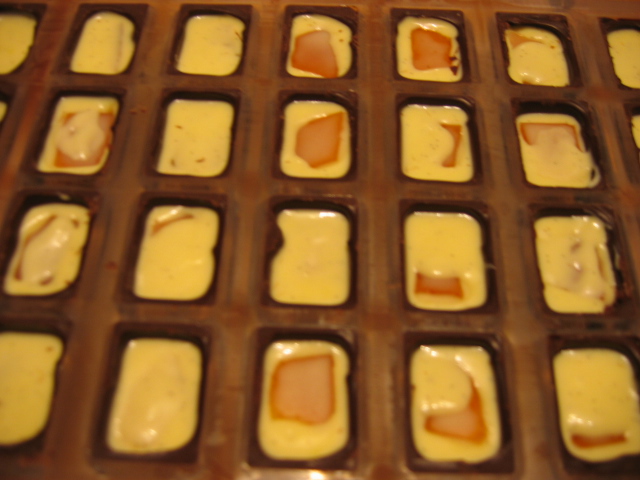
I placed the brulee on the bottom of half the pieces before placing them back in the fridge to set further.
I had been worried about backing off the bare creme pieces, but they proved to set thick enough that it wasn't a problem.
Then I took several dozen pieces to work and conducted a survey. Everyone who wanted to sample had to try one of each and vote for "Sugar crunch" or "No sugar crunch". I didn't get any complaints about the requirement to have two pieces.
I was concerned about the cocoa butter being too thick on the sugar, but to my suprise the vote came out 3 to 1 in favor of the sugar crunch. So the result was people prefer the full "creme brulee" experience even when encased in a chocolate shell.
Good idea, but these must be eaten immediatley? or within a day or two at most.
I am quite intrigued by the idea of a creme brulee truffle but it is it possible to get a decent shelf life ( 1-2 weeks) on a similar recipe?
Sorry for the delayed reply, but I've been away from the board for a while.
Yes, these are special in that they do need to be eaten within a couple days since the degree of water activity is extremly high. I imagine that you could make a version with ganache that would last much longer, but the texture would also be different.
thanks for posting the results, I always enjoy seeing how these experiments work out!
-
I'm very glad to be able to read all your comments.
emmalish--this is the first time I have used the mol d'art. I dipped things in chocolate without worrying about the temper before, with unpredictable results. I have been reading egullet and seventypercent and some other sites and bought the mol d'art. I was hoping to use a method described by some posters as "controlled melt", which is that the chocolate is in temper when you start, so you melt it gently enough to keep it within its temper range and it stays in temper. But it sounds like everyone using mol d'art does a melt and seed method, so I'll work on that next.
JPW also mentions that you can set it overnight at just the right temperature (calibrated to your machine). The top will be overcrystallized, the bottom will be undercrystallized, and when you mix it all together the next morning it will be just right. I've never gotten this method to work, but he says it's possible. I think if you search egullet archives, it is mentioned there too.
-
I just got my melter yesterday – thanks prairiegirl!
I haven't used it yet, but I've cleaned it up and gotten it ready for use tomorrow.
I've fiddled with the dial a bit though, and when I turn it on, I don't hear a "click" until the dial reads about 17-20°. Is that normal? Or does that mean my dial is off by about 20°?
The other thing that JPW has mentioned in his classes (according to reports here) is that every machine is different. So the temperature isn't absolute, it's relative.
-
Can you just buy smaller cherries? I can buy them in small, medium or large sizes. I prefer medium for hand dipping, and haven't tried molding them yet.
The picture in Greweling on P242 looks like it uses the jbprince (standard sized 25mm-deep, same deepness as lapin dor's) mold. I could be wrong though. His cherries look smaller.
-
-
I'm looking for a mold large enough for a full sized cherry (after casting the shell) without being too much larger.
I have a coworker who asked if I could duplicate his favorite "Asbach Chocolate Covered Brandied Cherries" as he couldn't find anyone who would ship to him. From what I can tell they are liqueur filled with brandied cherries in a molded dark chocolate bon-bon. The most interesting point is they claim not to have a sugar crust which makes me wonder how they close it off for bottoming.
I've had two canning jars of cherries in the fridge for several weeks now. One with straight brandy, the other with a fancier mix with sugar, lemon juice cinnamon, nutmeg, and vanilla in addition to the brandy.
Would this work?
http://www.jbprince.com/chocolate-and-suga...28-cavities.asp
30mm around 25mm deep.
No Sugar crust or no cocoa butter crust? Wasn't there that thread sometime ago about bottoming with cocoa butter for this type of thing? I can't remember exactly.
-
Based on Tiny's advice, I emailed Chef Greweling. He actually replied!!!!!! Chef confirms what tiny said: atomized glucose and powdered dextrose are different, and you can see the explanation below.
It looks to me like the person who posted got it right. There are a couple of things to consider:"glucose syrup" is a very unfortunate name, because it is usually shortened to "glucose"
Glucose is a synonym for Dextrose, which is a monosaccharide. Many industries, including medical, still use the name glucose for this sugar. (think blood glucose)
Glucose syrup is made by the partial breakdown of polysaccharides in starch into shorter chains of dextrose resulting in varying degrees of sweetness, viscosity, tendency to brown, etc.
So...Glucose syrup is not the same thing as glucose (the monosaccharide) resulting in much confusion.
As for powdered glucose syrup....it is simply glucose syrup, which is usually ~20% water, with most of that water removed. it is available in different DEs just as glucose syrup is. This may also be known as atomized glucose syrup, and unfortunately, the name is commonly shortened to powdered glucose.
Powdered dextrose is pure monosaccharide, and is an entirely different animal; essentially a 100 DE glucose syrup with the water removed.
Yes, I would say the poster got this one right, but it is a confusing subject, and the post requires careful reading.
If I can be of any further help to you, please do not hesitate to reach me at this e-mail address
Best Regards,
Peter P Greweling
"More on tract, since l'epicerie is asking you for retractions maybe it's a good time to put it away."
Only on the cremodan part, which I am happy to retract as my error (and which they noted and thanked me for in email).
Substituting dextrose without my knowledge and claiming they are the same because "Greweling says so" is pretty well documented and accepted by all involved. I did forward Chef's note to them. Just for their knowledge, not because I expect a refund or an exchange or anything.
Thanks for the http://www.le-sanctuaire.com/ recommendation and thanks to all who helped answer this question! I love this site!!!!!!!
-
Hey Tiny
Thanks for that. That's what I think too, in reading my books. Dextrose is one component of glucose, but glucose (the liquid) has other stuff too - explaining why powdered glucose isn't as sweet as powdered dextrose.
I'll try emailing Chef Greweling, who knows maybe he'll reply. That would be pretty sweet if he did reply.
-
I hold the spatula in my left hand, and have the blade on edge. I spray the end of the spatula by holding the gun in my right hand and holding it very close to the spatula. The mold is sitting on edge. I usually end up turning the mold to get all the areas splattered. The cocoa butter sprays on, rather than drips on. Not a great description. I hold the gun and spatula real close to the mold. I still have a lot of work to do on it before I am consistent. It uses a whole lot less cocoa butter than throwing with a brush (at least the way I throw:-)
THis sounds pretty cool, do you mind answering a few questions
1. you say the blade is on edge. THis sounds like vertical, correct??
2. You say you spray the end of the spatula. Are you aiming for the center of the spatula or slightly off? Do you get any spray directly into the mold accidently?
3. The mold is on edge, so I assume that means vertical rather than horizontal, correct?
-
Thank you Brian for that information about New York. I did not know that.
they sent me another email asking me to retract what I said about a previous mess up.
Their documentation shows I ordered "Pastry one Ice Cream stabilizer" and that is what I remember from my invoice as well. I received "Patisfrance Gel glace".
If they are the same, my apologies to l'epicerie on that incorrect memory. I am not a pro so I did not know they are the same, my fault.
In that email, they did tell me again that dextrose and atomized glucose are the same (see below)
The Dextrose we carry is made in the US from corn. The Atomized Glucose we are importing is made in Europe from wheat.From the entry on glucose on wikipedia one can read: "Two stereoisomers of the aldohexose sugars are known as glucose, only one of which (D-glucose) is biologically active. This form (D-glucose) is often referred to as dextrose monohydrate, or, especially in the food industry, simply dextrose (from dextrorotatory glucose[1]). This article deals with the D-form of glucose."
It looks like Peter P. Greweling of the Culinary Institute of America was right !
-
Yes, that response from your supplier was a little bit snarky?
I basically was paraphrasing Oriol Balaguers "Dessert Cuisine" and it's section on sugars.
The book has one of the most complete chapters ( rather a series of chapters) on ingredients used in desserts and chocolates including sugars.
He's also won numerous awards in Spain, his home country, as well as Europe.
But, I think the point still remains that the supplier shipped you ( for the second time?) product that you didn't order that they thought was a good enough replacement.
Without consulting you.
Greweling or not, that kind of remains questionable?
Thanks again tan319.
It was the 2nd time. The first time it was a gel glace for cremodan substitution. I only ordered one cremodan last time.
But this time I ordered 3 lbs of Atomized Glucose and got 3 lbs of Dextrose.
This recipe also uses both dextrose and atomized glucose, suggesting they are not the same. They even suggest lepicerie as a vendor.
http://findarticles.com/p/articles/mi_m0JA...ag=artBody;col1
I did say in my original email "I will be out of town these next few days so it's not a critical rush". I would've hoped that 3 days was enough time and that I wouldn't have to call. But maybe they do things differently.
*edit, l'epicerie's documentation shows I ordered Pastry One Ice Cream Stabilizer and I received Patisfrance Gel Glace. Maybe they are the same and if so that is my mistake and my apologies to l'epicerie for my error*
-
OK, I'm going to answer my own question.
I found a recipe from the 2006 World Pastry Class forum from Biagio Settpani (thanks Schneich for posting the link!!!). The recipe uses both powdered glucose and dextrose, suggesting strongly that they are not the same thing.
I think wikipedia http://en.wikipedia.org/wiki/Glucose clarifies the source of confusion.
Dextrose is a form of glucose (D-glucose pure, as it is labeled on the package). That is, it is one stereoisomer of glucose. isomers have the same chemical formula but different arrangements and thus different chemical properties.
Glucose will contain dextrose, but forms as well. This would be in line with what tan319 said earlier about it being less sweet, since it is the D-glucose form that is sweet (according to wikipedia).
-
Hey tan319
I'd be interested in what you think of L'epicerie's response. i cut and paste your answer to me and this is what they say
I am terribly sorry about the switch of products without your knowledge. I will make sure the warehouse keeps all our customers informed of changes. Please accept our apologies for the inconvenience this may have caused.Regarding the issue of Dextrose vs Glucose I beg to differ from the information given to you on eGullet and would like to refer from the book "Chocolates and Confections" by Peter P. Greweling of the Culinary Institute of America.
In the "Sweeteners" chapter. One can read:
Sucrose and derivatives
While the word sugar may rightfully be applied to a variety of nutritive carbohydrate sweeteners, when the term is used without any modifiers, it refers as sucrose. Sucrose is a disaccharide made up of one molecule of fructose (also known as levulose) bonded with one molecule of dextrose (also know as glucose). The sucrose commonly used in confectionery is one of the purest food substances available -- 99.8 percent of higher pure sucrose.
This may not close the discussion on Glucose/Dextrose but this information has the advantage of having been published by an authoritative author.
Best regards.
Again, thanks for your expertise on this. I appreciate that they actually responded this time, but I'm probably just going to buy wholesale next time and eat the extra cost. At least I'll get what I ordered.
-
Kerry asked me to tell you all about a little trick I am learning. It is spraying the cocoa butter onto a small spatula or even the back of a plastic spoon. The cocoa butter builds up and eventually splatters. I will attempt my first posting of pictures

I use a detail gun as I find an airbrush is just too small. It would probably help a ton if I ever had a lesson or knew anything about spraying!!
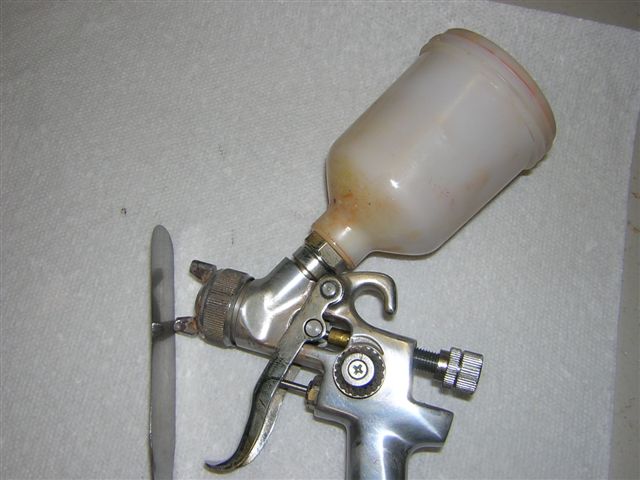
This is the angle I try to maintain while spraying. The cocoa butter builds up and you sort of use a sweeping motion with the air to get it to splatter. I usually hold the spatula vertical, but change it up when needed.

I am still messy, but not as bad as splattering with a brush.
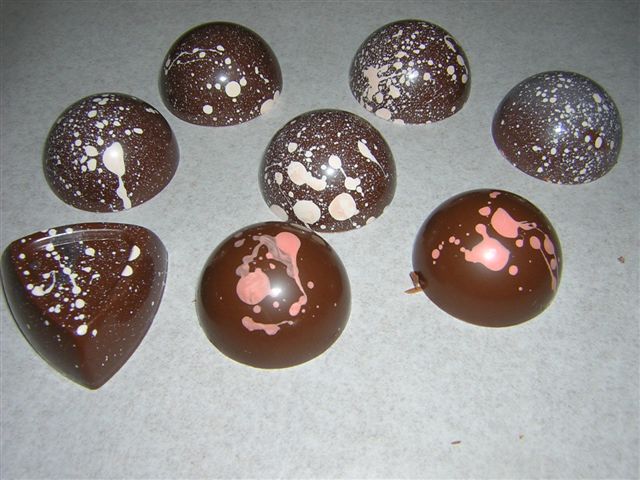
These were the results today. I mostly find out what doesn't work, rather than what does work
 I sprayed and shelled 8 trays in about 90 minutes using the gun and spatula. I also tried taking the nozzle off the gun and spraying with just the needle. It actually worked but you have to fiddle with the air mixture a lot.
I sprayed and shelled 8 trays in about 90 minutes using the gun and spatula. I also tried taking the nozzle off the gun and spraying with just the needle. It actually worked but you have to fiddle with the air mixture a lot. 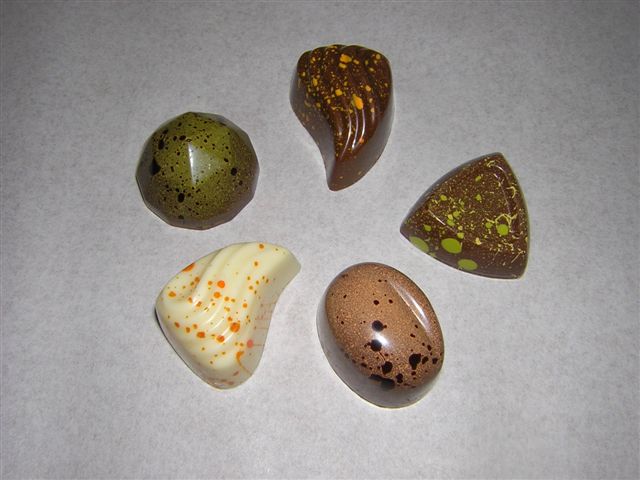
These are some that actually turned out.
I have a lot to learn and really appreciate all your help.
thanks for the pics! Do you mind expanding a little more on the sparaying part?
Do you hold te gun sideways and the spatula sideways relative to the molds? and the cocoa butter drips down in a splatter effect? Or does it reflect off the spatula in a spatter effect? Or is it some other mechanism?
-
Ok, this time I got the special spatter tip for the airbrush and this is the effect:
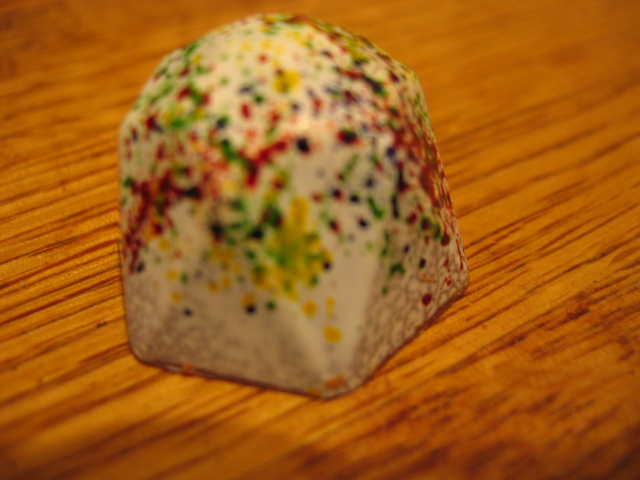

I had to experiment for a while to find the best way to use the brush. I found that the air source is far enough behind the paint tube that it was best to hold it almost vertical to get the cocoa butter to flow. I also had more luck pulling the needle back and letting it slam back to push more color out of the tube and get a good splat. All that added up to more work than I was hoping for and it took me a couple hours to paint three molds. Still, I had a LOT LESS mess than when I used a brush to flick the color.
Thanks for the tips. 2 hours for 3 molds! I'll stick with the other way it sounds like.

Working Cleanly in the Chocolate Kitchen
in Pastry & Baking
Posted · Edited by ejw50 (log)
Hi Darienne
This old thread, around page 10-12 there is discussion on the spatter technique.
DavidJ shows his spatter tip
Ruth Kendrick explains her modification to the spatter technique.
http://forums.egullet.org/index.php?showtopic=56184&st=330
Here is another one where TNChocolatier explains how to do it with the old fashioned way with a whisk
http://forums.egullet.org/index.php?showtopic=117072